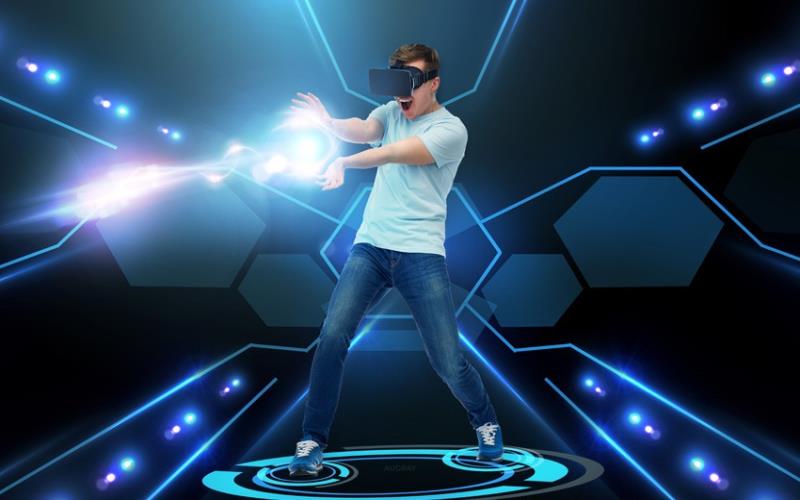Augmented reality, or AR for short, is a technology that adds digital elements to the real world. Imagine putting on a pair of special glasses and suddenly seeing video game characters or casino tables appear right in your living room. Sounds like something out of a science fiction movie, right? Well, it’s becoming more and more real every day. This article will dive deep into how augmented reality is changing the way we play video games and gamble in casinos. Joker123 ,We’ll look at the cool new experiences it offers, the challenges it faces, and what we can expect in the future.
Augmented Reality in Gaming: More Than Just a Game
In the realm of video games, augmented reality is acting as a catalyst for transformative experiences. Traditionally, video gaming has been a stationary activity where you would sit in front of a screen, controller in hand, and engage with a virtual world confined within the boundaries of that screen. Augmented reality shatters those boundaries, extending the gaming environment into your physical space. This is not merely an incremental change; it’s a paradigm shift that redefines the very essence of gaming. สล็อต888
Let’s delve into the mechanics of how this works. Augmented reality employs specialised software and often hardware, like AR glasses or even your smartphone, to overlay digital elements such as characters, objects, or landscapes onto the real world. In a shooting game, for instance, your living room might transform into a battlefield. You wouldn’t just press a button to dodge bullets; you’d physically move around your space to avoid getting hit. The tactile, kinetic involvement adds a layer of realism and immersion that traditional video games can’t offer.
But the impact of augmented reality on gaming isn’t limited to individual experiences; it extends to social interactions as well. Consider multiplayer games that use AR technology. These games could allow you and your friends to go on a virtual treasure hunt in your local park. The treasure, of course, is virtual, but the excitement and teamwork are very real. You’re not isolated, each staring at your own screen; instead, you’re in a shared physical space, collaborating to achieve a common virtual goal. This fusion of the real and digital worlds makes the gaming experience more communal and socially enriching.
Moreover, augmented reality can also serve educational purposes within gaming. Imagine a historical game where you walk through a real-world museum, and AR brings historical figures to life, offering interactive lessons in a way that a textbook never could. This not only makes learning more engaging but also adds an educational dimension to entertainment.
The social aspect of AR gaming also has potential therapeutic applications. For individuals with social anxiety or other conditions that make social interaction challenging, AR games can act as a bridge to more comfortable and controlled social experiences. The games can be designed to encourage positive social behaviours and reward collaboration, providing a safe space for people to practise social interaction while also having fun.
Augmented Reality in Casinos: A Virtual Bet in a Real World
The casino industry is another domain where augmented reality is making significant inroads, fundamentally altering how we engage with gambling environments. Traditional casinos have always been places where people gather in a physical location, surrounded by the glitz and glamour, the sounds of slot machines, and the tension around poker tables. However, augmented reality is poised to bring that entire experience into your personal space, effectively turning any location into a potential gambling hotspot.
Let’s explore the mechanics of how this could work. Augmented reality uses a combination of devices such as AR glasses, smartphones, or tablets and specialised software to superimpose digital elements onto the real world. In the context of a casino, this could mean having a virtual poker table appear right on your dining room table. You could sit in your favourite chair at home, put on your AR glasses, and suddenly find yourself facing a virtual dealer, ready to deal your cards. The tactile elements, like chips and cards, would be digital, but the table could be your actual, physical table, creating a blend of the real and the virtual that offers an incredibly immersive experience.
The convenience factor is undeniable. No longer would you need to plan a trip to a casino, worry about transportation, or navigate through crowds. Your casino experience could happen anytime you desire, right in the comfort of your own home. This opens up the world of gambling to people who might live far from a casino or who might have mobility issues that make travel difficult.
But convenience is just the tip of the iceberg. The real game-changer is the level of immersion that AR can offer. Imagine wearing AR glasses that not only bring a poker table into your living room but also enrich the environment with high-quality sound effects, from the shuffling of cards to the chatter of a crowd. Picture a roulette wheel that appears life-sized, spinning realistically in front of you as you place your bets through a simple gesture or voice command. The digital elements would be so seamlessly integrated into your physical environment that you’d almost forget you’re not in an actual casino.
Social interaction is another dimension where AR could have a profound impact on the casino experience. You could invite friends over for a virtual game night where everyone puts on AR glasses and engages in a round of blackjack or poker. The game would be virtual, but the social interactions conversations, reactions to wins or losses, and the general camaraderie would be as real as they come. This could redefine what we consider a “casino night” with friends, offering both the thrill of gambling and the warmth of social interaction in a single, augmented package.
Challenges: Not Everything is Rosy
While the potential of augmented reality in both gaming and casinos is enormous, it’s crucial to acknowledge the hurdles that stand in the way of widespread adoption. One of the most significant barriers is the financial aspect. High-quality AR devices, such as advanced AR glasses, can be quite expensive. This high cost could limit the technology’s accessibility, making it a luxury that only a select few can afford. For AR to truly revolutionise gaming and casinos, it needs to be accessible to a broader audience, which means that manufacturers will have to find a way to make these devices more affordable without compromising on quality.
Safety is another concern that cannot be overlooked. Augmented reality often requires physical movement, especially in gaming scenarios. For instance, if you’re playing an AR shooting game that involves dodging bullets, you’ll likely be moving around your living space quite a bit. This opens up the possibility of accidents tripping over a rug, bumping into furniture, or even colliding with another person. The challenge for game developers and casino operators is to design AR experiences that are not only immersive and engaging but also safe. This might involve creating games that can adapt to the size and layout of a player’s environment or developing safety features that alert players if they’re about to encounter a real-world obstacle.
Future Prospects: What Lies Ahead
As we look toward the future, the landscape for augmented reality in gaming and casinos appears promising, albeit with challenges to overcome. Technological advancements are likely to make AR devices more affordable, thereby widening their reach. Companies are already investing heavily in research and development to create AR experiences that are more realistic, engaging, and safe. For example, future AR glasses might come with advanced spatial awareness capabilities that can map out your environment in real-time, helping to prevent accidents.
Moreover, as AR technology becomes more sophisticated, we can expect even more immersive experiences. Imagine AR casino games where the virtual dealer can recognize and respond to your facial expressions, or AR adventure games where the storyline adapts based on your real-world interactions. These are not far-fetched ideas; they are the next logical steps in the evolution of augmented reality entertainment.
In the coming years, we can anticipate a surge in the development of AR games and casino platforms. These won’t just be novelties or experimental projects but could become integral parts of mainstream entertainment. As this happens, both industries will need to navigate the challenges of cost and safety, but the potential rewards both in terms of profit and user experience are too significant to ignore.
A Revolution in Digital Entertainment
The advent of augmented reality is not merely an incremental advancement in technology; it represents a seismic shift in the way we engage with digital entertainment. This transformative technology has the power to elevate our gaming and casino experiences to unprecedented levels of immersion and interactivity. Whether it’s turning our living rooms into virtual battlegrounds or allowing us to experience the thrill of a casino without ever leaving our homes, augmented reality is poised to redefine the boundaries of what is possible in both gaming and gambling.
However, like any revolutionary technology, augmented reality comes with its own set of challenges that need to be addressed. From the economic barriers posed by the high cost of AR devices to the safety concerns arising from physical movement during gameplay, there are hurdles that must be overcome. Yet, these challenges are not insurmountable. As technology continues to evolve, we can expect solutions that make AR more affordable, safe, and accessible to a broader audience.
Looking ahead, the prospects for augmented reality in digital entertainment are incredibly promising. With ongoing advancements in AR technology, coupled with increasing investment in research and development, we are on the cusp of a new era. An era where digital experiences are not confined to screens but are integrated into our physical world, enriching our interactions and making them more social and engaging.





